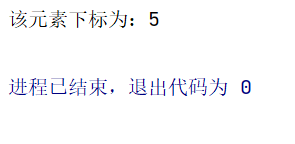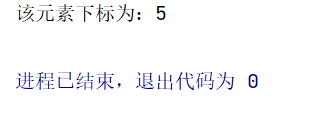数据结构与算法查找算法

目录
数据结构与算法——查找算法
目录
一、查找算法
1.1 分类
- 线性查找
- 二分查找
- 插值查找
- 斐波那契查找
二、线性查找(SequenceSearch)
2.1 基本思想
逐一比对待排序序列,找出待查找元素的下标。
2.2 线性查找算法实现
代码:
public class SequenceSearch {
public static void main(String[] args) {
int arr[] = {8, 9, 1, 7, 2, 3, 5, 4, 6, -1};
int index = search(arr, 2);
if (index == -1) {
System.out.println("序列中不存在该元素。");
} else {
System.out.println("该元素下标为:" + index);
}
}
public static int search(int[] arr, int value) {
//逐一比对待排序序列
for (int i = 0; i < arr.length; i++) {
if (arr[i] == value) {
return i;
}
}
return -1;
}
}结果:

三、二分查找(BinarySearch)
3.1 基本思想
先确定有序序列的中间下标,然后向左右两边递归进行二分查找,直到中间下标为 待查找元素的下标 。
3.2 二分查找算法实现
代码:
public class BinarySearch {
public static void main(String[] args) {
int arr[] = {-1, 1, 2, 3, 4, 5, 6, 7, 8, 9};
int index = search(arr, 0, arr.length - 1, 5);
if (index == -1) {
System.out.println("序列中不存在该元素。");
} else {
System.out.println("该元素下标为:" + index);
}
}
public static int search(int[] arr, int startIndex, int endIndex, int value) {
if (startIndex > endIndex || value < arr[0] || value > arr[arr.length - 1]) {
return -1;
}
//定义中间元素下标
int mid = (startIndex + endIndex) / 2;
//定义中间元素值
int midVal = arr[mid];
if (value > midVal) {
//向右递归
return search(arr, mid + 1, endIndex, value);
} else if (value < midVal) {
//向左递归
return search(arr, startIndex, mid - 1, value);
} else {
return mid;
}
}
}结果:

四、插值查找(InterpolationSearch)
4.1 基本思想
类似于二分查找,但改变了每次查找的期望索引值。
4.2 期望索引值公式
Expectation = startIndex + (endIndex - startIndex) * (value - arr[startIndex]) / (arr[endIndex] - arr[startIndex])
4.3 插值查找算法实现
代码:
public class InterpolationSearch {
public static void main(String[] args) {
int arr[] = {-1, 1, 2, 3, 4, 5, 6, 7, 8, 9};
int index = search(arr, 0, arr.length - 1, 5);
if (index == -1) {
System.out.println("序列中不存在该元素。");
} else {
System.out.println("该元素下标为:" + index);
}
}
public static int search(int[] arr, int startIndex, int endIndex, int value) {
if (startIndex > endIndex || value < arr[0] || value > arr[arr.length - 1]) {
return -1;
}
//定义期望元素下标
int expectation = startIndex + (endIndex - startIndex) * (value - arr[startIndex]) / (arr[endIndex] - arr[startIndex]);
//定义期望元素值
int expectationVal = arr[expectation];
if (value > expectationVal) {
//向右递归
return search(arr, expectationVal + 1, endIndex, value);
} else if (value < expectationVal) {
//向左递归
return search(arr, startIndex, expectationVal - 1, value);
} else {
return expectationVal;
}
}
}结果:

五、斐波那契查找(FibonacciSearch)
5.1 基本介绍
斐波那契查找算法又称黄金分割查找算法,黄金分割点是指把一条线段分割成两部分,使其中一部分与全长之比等于另一部分与该部分之比,该比值的近似值为0.618。
相邻两个元素之比无限接近黄金分割值的数列被称为斐波那契数列。
5.2 基本思想
类似于二分查找,但改变了每次查找的期望索引值,该期望索引值位于黄金分割点附近。
5.3 期望索引值公式
Expectation = startIndex + F(k - 1) - 1,F表示斐波那契数列。
- 由斐波那契数列F(k) = F(k - 1) + F(k - 2)的性质可得:(F(k) - 1) = (F(k - 1) - 1) + (F(k - 2) - 1) + 1,该式说明只要有序序列的长度为F(k) - 1,则可以将该序列分成长度为F(k - 1) - 1和F(k - 2) - 1的两部分,期望索引值的下标为startIndex + F(k - 1) - 1。
- 当有序序列的长度不为F(k) - 1时,需要将该序列的长度增加至F(k) - 1。
5.4 斐波那契查找算法实现
代码:
public class FibonacciSearch {
//定义斐波那契数列的长度
public static int maxSize = 20;
public static void main(String[] args) {
int arr[] = {-1, 1, 2, 3, 4, 5, 6, 7, 8, 9};
int index = search(arr, 5);
if (index == -1) {
System.out.println("序列中不存在该元素。");
} else {
System.out.println("该元素下标为:" + index);
}
}
public static int search(int[] arr, int value) {
//定义头指针
int startIndex = 0;
//定义尾指针
int endIndex = arr.length - 1;
//定义期望元素下标
int expectation = 0;
//定义斐波那契分割数值的下标
int k = 0;
//定义斐波那契数列
int[] f = fibonacci();
//获取斐波那契分割数值
while (endIndex > f[k] - 1) {
k++;
}
//有序序列长度不足时增加其长度,存入临时数组中,不足部分使用arr数组末尾的值进行填充
int[] temp = Arrays.copyOf(arr, f[k]);
for (int i = endIndex + 1; i < temp.length; i++) {
temp[i] = arr[endIndex];
}
while (startIndex <= endIndex) {
expectation = startIndex + f[k - 1] - 1;
//定义期望元素值
int expectationVal = arr[expectation];
if (value > expectationVal) {
//向右查找
startIndex = expectation + 1;
//右边的有序序列有f[k-2]个元素,可拆分成f[k-2]=f[k-3]+f[k-4],k-2作为新的斐波那契分割数值的下标
k -= 2;
} else if (value < expectationVal) {
//向左查找
endIndex = expectation - 1;
//左边的有序序列有f[k-1]个元素,可拆分成f[k-1]=f[k-2]+f[k-3],k-1作为新的斐波那契分割数值的下标
k--;
} else {
//判断查找到的元素下标是否位于增加出的部分,是则返回数组末尾下标
if (expectation <= endIndex) {
return expectation;
} else {
return endIndex;
}
}
}
return -1;
}
//获取斐波那契数列
public static int[] fibonacci() {
int[] f = new int[maxSize];
f[0] = 1;
f[1] = 1;
for (int i = 2; i < maxSize; i++) {
f[i] = f[i - 1] + f[i - 2];
}
return f;
}
}结果:
